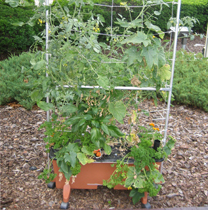|

Kitchen Gardens
Whether you're adding edible plants to an existing landscape or deciding where to put the veggies in a brand new yard, it is best to start with a design for what goes where. Some plants grow tall, others grow wide and taking this into account, is a primary factor in creating the design. If you are adding veggies and herbs among existing plants, be especially careful about placing veggies with either high or low water requirements next to plants with the same needs.
Planning checklist:
- Look at your available space -- especially the sunny areas where most vegetables will thrive -- and select the areas where you might add vegetables.
- Do you have room for plants that grow low and wide like cucumbers? If not, consider adding an obelisk or a trellis so the spreaders can grow up instead of out.
- Check the water requirements of potential vegetables and herbs against plants already in the landscape. Placing veggies that need regular water among plants that require little or no water is generally not a good idea.
You can have a chicken and eat its egg, too
Since June 20, 2011 residents of Denver are among cities allowing residents to have chickens in their yards—up to 8 hens or ducks. Long-time gardeners say when chickens peck at the soil, they actually rototill the garden and their waste creates fertilizer. They add one more sustainable option for the landscape.
Just like any other new element to your yard, incorporating chickens successfully requires proper planning. Have a designer help create a plan that adds chickens in the best way possible for your needs and theirs. Their new home can be a very simple coop or it can add an artistic element in your landscape by making their coop a replica of your home or a little castle or even a giant egg.
Know the benefits of having chickens
- Their scratching in the yard or garden area is very beneficial to the soil. Healthy soil breeds healthy plants.
- They provide pest control by eating insects like aphids, tics and tomato worms. This helps to protect produce from insect damage, to reduce the need for insect treatments and to save the gardener maintenance time.
- They can be fed kitchen scraps, which means you can recycle food waste.
- They lay eggs—about two per day per hen. Depending on the variety, their most productive laying time is about two years.
- Daily maintenance time for a few hens requires less time than it takes to care for a dog.
What do the chickens need?
- Adequate shade, space and shelter that offer 6-10 sq. ft. per bird and protection from predators.
- Their enclosure needs to be free from drafts and moisture and with a straw bed where they can lay eggs.
- Know that you will need to monitor their movements when they are out of the coop. They will eat weeds, but they will also eat your lettuce, basil and cilantro. Giving them free and unsupervised reign of the kitchen garden is not a good idea.
What about their waste droppings?
- Chickens are quite prolific in waste production -- and their waste provides good organic matter for the lawn and garden.
- The nitrogen content of their waste is only about 1/10th the nitrogen that a lawn needs during the year, but a consistent, ongoing supply still adds fertilizer and organic matter to the lawn. Regular mowing with a mulching mower keeps waste productively recycled so it benefits the lawn.
- By placing compostable material in their coop, you can collect that material with the waste, and use it in the garden.
See a segment on KUSA 9News when Lauren Bloom, ALCC expert, talked with 9News anchor, Mark Koebrich, about what chickens need to live happily in anyone's yard.
Have a kitchen garden even if you don't have a yard
If you have a balcony or small patio, you can still grow those veggies. Many vegetables are well-suited to being grown in containers. Special "earth boxes," like the one pictured above, are space-saving and mobile because they have wheels and can accommodate more than one kind of plant at a time. A trellis on the back of the box gives spreaders a place to climb so there's space left in front for other vegetables like peppers that are more compact.
You can also turn last year's petunia pots into a place for tomatoes. Just add an obelisk to pots you already have and tomatoes and similar spreading plants will be supported by the structure. Herbs are also great for containers. They can be combined so that several are growing in just one pot. Another benefit: They are also attractive.
Design to deter pests
When designing your planting area, incorporate plants that deter or are undesirable to pesky critters in your garden. Fragrances are often great deterrents to pests and they can be found in many herbs, shrubs or perennials. If some plants are not available in your area, essential oils will also work. Marigolds, especially French Marigolds, are easy to grow, available in just about all climates and attract many beneficial insects that can help protect your garden from being stripped by unwanted visitors. Some beneficial insects like ladybugs can also be purchased to release in your yard.
Deer. Place shavings of Ivory or Irish soap around plants. This method sometimes has mixed results -- but if it works with the deer in your neighborhood, it's worth the effort. Also hang a salt lick in their path so the deer will be attracted to the salt lick and leave your plants alone.
Rabbits. Rabbits can be deterred from plants they like to chomp by sprinkling chili pepper around the plants -- just remember it needs to be reapplied after the area gets wet from either rain or sprinklers. Another effective product to place around plants is blood meal which is available in several brands from local garden centers. Because rabbits are prey animals, they react to the smell of blood and stay away. The meal is not harmful to pets and it's actually good for plants because of the nitrogen it contains. Some plants are rabbit resistant - so try these plants in your garden: Bellflower, Asilbe, Aster, Yarrow, Cranesbill, Hosta, Lavender, Sage and other textured or thorny plants. Rabbits generally dislike marigolds, so here's a plant to place around the ones you don't want them to eat. Finally, rabbits will not each squash, cucumbers, tomatoes (although sometimes they will "taste" the stems), corn, potatoes or peppers.
Mice. Mice do not like mint -- especially peppermint. So having mint in your garden is a deterrent to this unwanted rodent.
Coyotes. Coyotes most likely won't be jumping your fence to eat veggies, but they are still unwanted pests now becoming prevalent in many urban areas. Usually, their goal is to eat pet food left outdoors. But whether they're eating veggies or dog food, they're still undesirable. A recent invention that can be mounted on the fence keeps coyotes from jumping over the fence. It's called a Coyote Roller and can be checked out at www.coyoteroller.com.
Seeing big populations of insects on plants -- particularly trees and shrubs -- usually indicates the plants are under stress as that's where insects will always go first. There can be a variety of factors that cause plants to be stressed and they range from sun exposure, to soil type, to water requirements and other factors. Because trees and shrubs are your long-term and most expensive landscape investment, it's best to consult a pro to diagnose the underlying problems and to determine the best treatment options. For other infestations in and around your veggie garden, here are some suggestions:
Ants: Set out cucumber (bitter is best) peels or slices; they won't cross them. Soak a string in cayenne pepper, citrus oil, clove oil, lemon juice or sprinkle coffee grounds where you want to deter them and they will not cross it. Garlic is another deterrent and spraying soap and water to an area will also deter ants.
Aphids: Chives, marigolds, mint, basil or cilantro are good deterrents to aphids. You can also try placing aluminum foil at the base of the plant which by reflecting light under the leaf helps to deter the aphids.
Grasshoppers: Use garlic oil, calendula, the herb horehound and cilantro.
Slugs: Slugs do not like mint, lemon balm, human hair (remove excess hair from hairbrushes and put into gardens), pine needles, Cosmos, sage and parsley.
|


